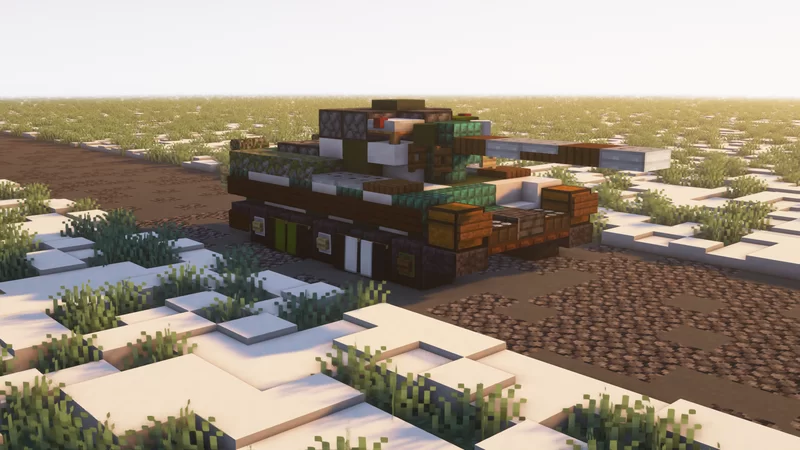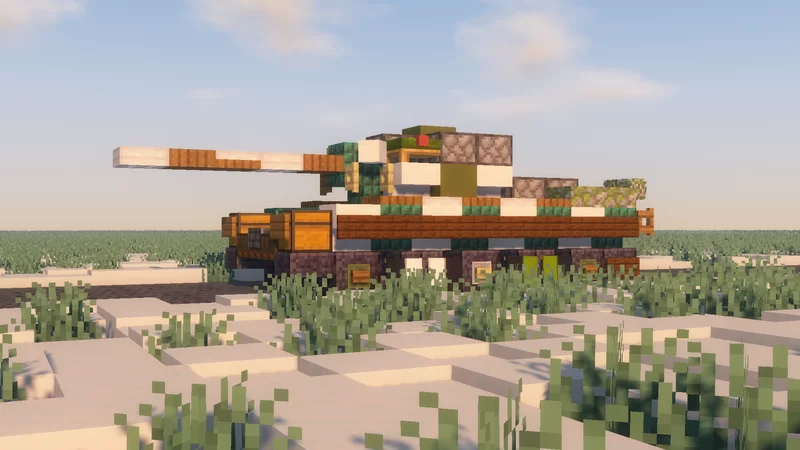91
After improved German Panzer IVs with the high-velocity 7.5cm (2.95 in) KwK 40 gun were encountered in combat in 1942, a project to design an entirely new Soviet tank was begun, with the goals of increasing armour protection while adding modern features like a torsion-bar suspension and a three-man turret. The new tank, the T-43, was intended to be a universal model to replace both the T-34 and the KV-1 heavy tank. However, the T-43 prototype's armour, though heavier, was not capable against German 88 mm guns, while its mobility was found to be inferior to the T-34. Finally, although the T-43 shared over 70% of its components with the T-34, manufacturing it would still have required a significant slow-down in production.[115] Consequently, the T-43 was cancelled.
Not only were the weapons of German tanks improving, so was their armour. Soviet firing tests against a captured Tiger I heavy tank in April 1943 showed that the T-34's 76 mm gun could not penetrate the front of the Tiger I at all, and the side only at very close range. A Soviet 85 mm anti-aircraft gun, the M1939 (52-K), was found capable of doing the job, and so derivatives of it were developed for tanks.[116][117] One of the resulting guns used on the original T-34 85 model (the D-5T) was capable of penetrating the Tiger I's upper hull armour at 1,000 metres.[77] It was still not enough to match the Tiger, which could destroy the T-34 from a distance of 1,500 to 2,000 m (4,900 to 6,600 ft),[118] but it was a noticeable improvement.
Rear view of a T-34-85 from Factory 174. In the center is a circular transmission access hatch, flanked by exhaust pipes, MDSh smoke canisters on the hull rear, and extra fuel tanks on the hull sides.
With the T-43 canceled, the Soviet command made the decision to retool the factories to produce an improved version of the T-34. Its turret ring was enlarged from 1,425 mm (56 in) to 1,600 mm (63 in), allowing a larger turret to be fitted supporting the larger 85 mm gun. The prototype T-43's turret design was hurriedly adopted by Vyacheslav Kerichev at the Krasnoye Sormovo Factory to fit the T-34.[119] This was a larger three-man turret, with radio (previously in the hull) and observation cupola in the roof. Now the tank commander needed only to command (aided by cupola and radio systems), leaving the operation of the gun to the gunner and the loader. The turret was bigger and less sloped than the original T-34 turret, making it a bigger target (due to the three-man crew and bigger gun), but with thicker 90 mm armour, making it more resistant to enemy fire. The shells were 50% heavier (9 kg) and were much better in the anti-armour role, and reasonable in a general purpose role, though only 55–60 could be carried, instead of 90–100 of the earlier shells. The resulting new tank, the T-34-85, was seen as a compromise between advocates for the T-43 and others who wanted to continue to build as many 76 mm-armed T-34s as possible without interruption.[120]
Interior of a T-34-85 viewed from the driver's hatch, showing the ammunition boxes on which the loader had to stand in the absence of a turret basket. In the foreground is the driver's seat. Levers for radiator flaps can be seen on the firewall.
Production of the T-34-85 began in January 1944 at Factory No. 112, first using the D-5T 85 mm gun. Parallel to the production of the T-34-85 with the D-5T gun, production of the T-34-85 using the S-53 gun (later to be modified and redesignated as the ZIS-S-53 gun) began in February 1944 at Factory No. 112.[121] The improved T-34-85 became the standard Soviet medium tank, with an uninterrupted production run until the end of the war. A T-34-85 initially cost about 30 percent more to produce than a Model 1943, at 164,000 Rbls; by 1945 this had been reduced to 142,000 Rbls –[122] during the course of World War II the cost of a T-34 tank had almost halved, from 270,000 Rbls in 1941,[122] while its top speed remained about the same, and its main gun's armour penetration and turret frontal armour thickness both nearly doubled.[123]
The T-34-85 gave the Red Army a tank with better armour and mobility than the German Panzer IV tank and StuG III assault gun. While it could not match the armour or weapons of the heavier Panther and Tiger tanks, its improved firepower made it much more effective than earlier models, and overall it was more cost-effective than the heaviest German tanks. In comparison with the T-34-85 program, the Germans instead chose an upgrade path based on the introduction of completely new, expensive, heavier, and more complex tanks, greatly slowing the growth of their tank production and helping the Soviets to maintain a substantial numerical superiority in tanks.[124] By May 1944, T-34-85 production had reached 1,200 tanks per month.[125] In the entire war, production figures for all Panther types reached no more than 6,557, and for all Tiger types (including the Tiger I and Tiger II) 2,027.[126] Production figures for the T-34-85 alone reached 22,559.[citation needed]
On 12 January 1945, a column of Tiger IIs and other tanks from 424th Heavy Panzer Battalion were involved in a short-range engagement with T-34-85 tanks near the village of Lisow. Forty T-34-85 tanks commanded by Colonel N. Zhukov were attacked by the 424th Heavy Panzer battalion, which had been reinforced by 13 Panthers. The Germans permanently lost five Tiger IIs, seven Tiger Is and five Panthers for the loss of four T-34-85 tanks burnt out.[127][unreliable source?][128]
Not only were the weapons of German tanks improving, so was their armour. Soviet firing tests against a captured Tiger I heavy tank in April 1943 showed that the T-34's 76 mm gun could not penetrate the front of the Tiger I at all, and the side only at very close range. A Soviet 85 mm anti-aircraft gun, the M1939 (52-K), was found capable of doing the job, and so derivatives of it were developed for tanks.[116][117] One of the resulting guns used on the original T-34 85 model (the D-5T) was capable of penetrating the Tiger I's upper hull armour at 1,000 metres.[77] It was still not enough to match the Tiger, which could destroy the T-34 from a distance of 1,500 to 2,000 m (4,900 to 6,600 ft),[118] but it was a noticeable improvement.
Rear view of a T-34-85 from Factory 174. In the center is a circular transmission access hatch, flanked by exhaust pipes, MDSh smoke canisters on the hull rear, and extra fuel tanks on the hull sides.
With the T-43 canceled, the Soviet command made the decision to retool the factories to produce an improved version of the T-34. Its turret ring was enlarged from 1,425 mm (56 in) to 1,600 mm (63 in), allowing a larger turret to be fitted supporting the larger 85 mm gun. The prototype T-43's turret design was hurriedly adopted by Vyacheslav Kerichev at the Krasnoye Sormovo Factory to fit the T-34.[119] This was a larger three-man turret, with radio (previously in the hull) and observation cupola in the roof. Now the tank commander needed only to command (aided by cupola and radio systems), leaving the operation of the gun to the gunner and the loader. The turret was bigger and less sloped than the original T-34 turret, making it a bigger target (due to the three-man crew and bigger gun), but with thicker 90 mm armour, making it more resistant to enemy fire. The shells were 50% heavier (9 kg) and were much better in the anti-armour role, and reasonable in a general purpose role, though only 55–60 could be carried, instead of 90–100 of the earlier shells. The resulting new tank, the T-34-85, was seen as a compromise between advocates for the T-43 and others who wanted to continue to build as many 76 mm-armed T-34s as possible without interruption.[120]
Interior of a T-34-85 viewed from the driver's hatch, showing the ammunition boxes on which the loader had to stand in the absence of a turret basket. In the foreground is the driver's seat. Levers for radiator flaps can be seen on the firewall.
Production of the T-34-85 began in January 1944 at Factory No. 112, first using the D-5T 85 mm gun. Parallel to the production of the T-34-85 with the D-5T gun, production of the T-34-85 using the S-53 gun (later to be modified and redesignated as the ZIS-S-53 gun) began in February 1944 at Factory No. 112.[121] The improved T-34-85 became the standard Soviet medium tank, with an uninterrupted production run until the end of the war. A T-34-85 initially cost about 30 percent more to produce than a Model 1943, at 164,000 Rbls; by 1945 this had been reduced to 142,000 Rbls –[122] during the course of World War II the cost of a T-34 tank had almost halved, from 270,000 Rbls in 1941,[122] while its top speed remained about the same, and its main gun's armour penetration and turret frontal armour thickness both nearly doubled.[123]
The T-34-85 gave the Red Army a tank with better armour and mobility than the German Panzer IV tank and StuG III assault gun. While it could not match the armour or weapons of the heavier Panther and Tiger tanks, its improved firepower made it much more effective than earlier models, and overall it was more cost-effective than the heaviest German tanks. In comparison with the T-34-85 program, the Germans instead chose an upgrade path based on the introduction of completely new, expensive, heavier, and more complex tanks, greatly slowing the growth of their tank production and helping the Soviets to maintain a substantial numerical superiority in tanks.[124] By May 1944, T-34-85 production had reached 1,200 tanks per month.[125] In the entire war, production figures for all Panther types reached no more than 6,557, and for all Tiger types (including the Tiger I and Tiger II) 2,027.[126] Production figures for the T-34-85 alone reached 22,559.[citation needed]
On 12 January 1945, a column of Tiger IIs and other tanks from 424th Heavy Panzer Battalion were involved in a short-range engagement with T-34-85 tanks near the village of Lisow. Forty T-34-85 tanks commanded by Colonel N. Zhukov were attacked by the 424th Heavy Panzer battalion, which had been reinforced by 13 Panthers. The Germans permanently lost five Tiger IIs, seven Tiger Is and five Panthers for the loss of four T-34-85 tanks burnt out.[127][unreliable source?][128]
| Progress | 100% complete |
| Tags |
5832826
2



















![[INTERIOR] log cabin Minecraft Map & Project](https://static.planetminecraft.com/files/image/minecraft/project/2024/125/17832099-projektbeznazwy_s.jpg)

Create an account or sign in to comment.